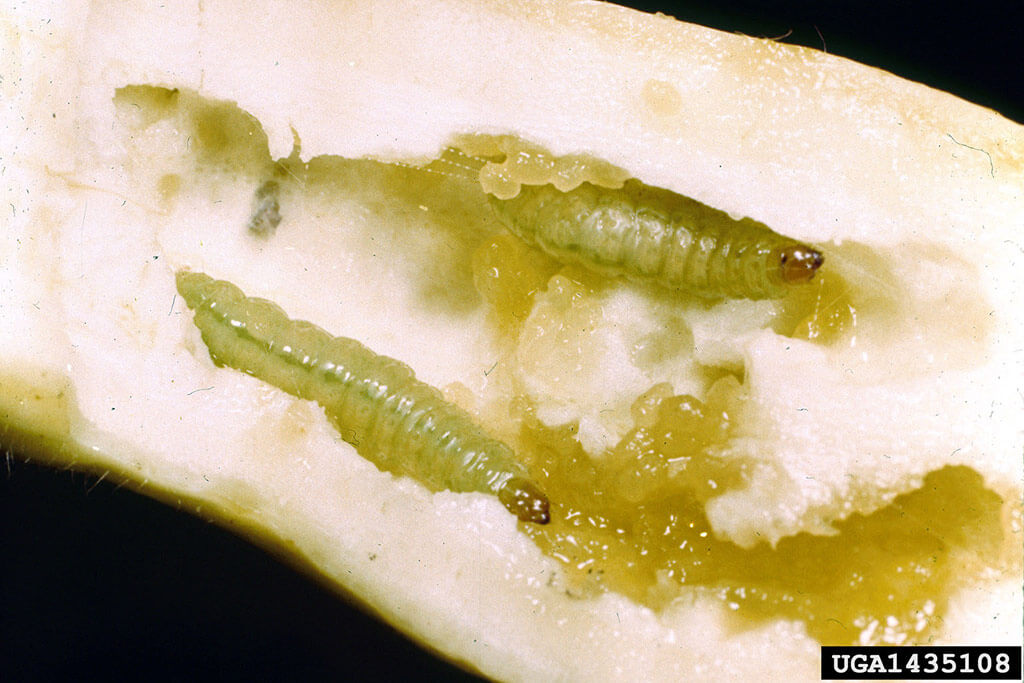
Pickleworms prey on summer squash and other seasonal produce, especially in the Southern regions of the United States. They leave tell-tale tunnels in fruits and can be difficult to control once they've made their way inside your plants. However, there are a number of prevention and control strategies you can implement so you can pick a peck of pickleworm-free produce come harvest time.
How to get rid of pickleworms
What are pickleworms?
Pickleworms are the larvae of the pickleworm moth (Diaphania nitidalis). This widespread pest ruins summer squash, their favorite meal, by burrowing into and feeding inside the fruit. They also attack cucumbers, cantaloupes, and pumpkins. However, winter squash and watermelon are rarely damaged. On cantaloupe they're referred to as rindworms because they feed on just the surface of the tough-skinned melon, only causing scarring.
The caterpillars may tunnel through flowers, buds, and stems, but most usually prefer fruits. Sometimes you'll see their frass, or waste, coming out of small holes in damaged fruits. But sometimes, you won't notice the entrance hole or damage until you harvest and cut the fruit.
Pickleworms can be difficult to pinpoint because they undergo numerous changes in size and color as they mature. Newly hatched larvae are colorless. Younger larvae have a row of small, dark, raised dots (known as tubercles) with a bristly hair (known as seta) protruding from each. Mature larvae range in color from light yellow to green, and do not have tubercles.
Pickleworms spend winter in frost-free parts of Southern Florida and Texas. The infestation creeps northward through spring to late summer, following the warm weather. Pickleworms have been reported as far north as Canada. The arrival of cold weather slows their activity, as they cannot overwinter where frost occurs.
How do I prevent pickleworms?
Luckily, there are a number of ways to outsmart these pests. Here are some reliable ways to help keep pickleworms out of your garden.
- Plant as early as possible. Infestations are worst on late-planted crops as the insects move north.
- Use row covers. Create a physical barrier between pickleworms and your plants with a sheer netting (learn more about row covers).
- Remove ripe fruits and diseased plants promptly. Don't give pickleworms a place to hide!
How do I get rid of pickleworms?
Because they're protected inside the fruit, it's nearly impossible to kill pickleworms. However, there are a number of things you can do to stop future stages of development.
- Destroy damaged fruit. Throw it in the trash to prevent pickleworms from reproducing in your compost pile.
- Crush rolled sections of leaves on damaged plants. This is where pupae hide and then emerge as adult moths, ready to repeat the pickleworm lifecycle.
- Spray plants with an approved insecticide. Look for one designed to control pickleworms, such as Ortho® Bug B-gon™ Lawn & Landscape Insect Killer Ready-to-Spray. Be sure to follow label directions.
Need more info and local pesticide recommendations? Contact your regional Extension agent. You can find the nearest Extension office through the Cooperative Extension System map.
Pickleworms can put your garden into, well, a pickle. But you can fight back with clever prevention strategies and taking quick action if you do notice an infestation.








 Herbs
Herbs
 Vegetables
Vegetables
 Fruit
Fruit
 Flowers
Flowers
 Succulents
Succulents

